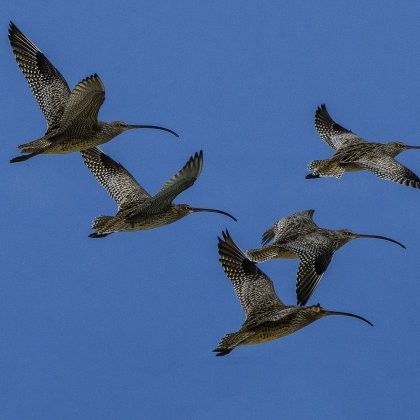91% of Migratory Birds at Risk Due to Habitat Loss
| Ana Verayo | | Dec 06, 2015 06:30 AM EST |
(Photo : Dirk Hovorka/University of Queensland) The Far Eastern Curlew are suffering rapid declines from loss of habitat along their flight path between Siberia and Australia.
Scientists are now warning that many migratory bird populations could face extinction due to habitat loss during their long distance flight migrations unless greater international protection efforts are implemented soon.
Although there are existing yet poorly coordinated efforts for global conservation, it still left almost 90 percent of all the migratory bird populations, not properly protected.
Like Us on Facebook
According to lead author of the study, Claire Runge from the University of Queensland in Australia, more than half of migratory birds that are travelling across the world's main flyways have been suffering from significant declines in populations for the past three decades. This is mainly caused by unequal and ineffective protection across their migratory range especially the places they stop to rest and refuel along their routes.
Researchers from the ARC Center of Excellence for Environmental Decision discovered that there are gaps in global conservation efforts that are directly affecting migratory birds, and these are found in places across India, China and other parts of South America and Africa.
Runge says that this problem has become prevalent since most migratory birds often rest in different geographical regions for their yearly feeding cycle of resting and breeding. Many species risk crossing entire continents to search for warmer habitats, away from winter months to breed. However, Runge points out that this long distance migration significantly puts a strain on the birds, where they lose weight and become weaker during their journey.
Runge also adds that even if humans provide protection to most of the birds' breeding grounds, it is still not enough as there are threats somewhere that can still affect the entire bird population, breaking the chain at any link.
Researchers have already observed some evidence, detailing in this new study when they gathered data from the migratory birds' movement throughout the year and comparing this information with maps of protected areas in different habitats such as wetlands, forests, savannas and the Arctic tundra and desert habitats.
According to biologist Richard Fuller from the University of Queensland, the data were overlaid on top pf each other and the team analyzed how well protected each migratory species across its flightpath during its entire yearly cycle. The results revealed that more than 90 percent of the species have one or more crucial parts of their life cycle are found in the world's poorly protected regions.
Among the 8,200 crucial stopover points for migratory bird species, only 22 are completely protected.
Individual nations can protect habitats with borders however, to completely protect the planet's migratory birds, it will require international collaboration and coordination, researchers recommend. This new study is published in the journal Science.
Tagsmigratory birds at risk, Birds, bird migration, bird conservation, habitat loss migratory birds
©2015 Chinatopix All rights reserved. Do not reproduce without permission
EDITOR'S PICKS
-

Did the Trump administration just announce plans for a trade war with ‘hostile’ China and Russia?
-

US Senate passes Taiwan travel bill slammed by China
-

As Yan Sihong’s family grieves, here are other Chinese students who went missing abroad. Some have never been found
-

Beijing blasts Western critics who ‘smear China’ with the term sharp power
-

China Envoy Seeks to Defuse Tensions With U.S. as a Trade War Brews
-

Singapore's Deputy PM Provides Bitcoin Vote of Confidence Amid China's Blanket Bans
-

China warns investors over risks in overseas virtual currency trading
-

Chinese government most trustworthy: survey
-

Kashima Antlers On Course For Back-To-Back Titles
MOST POPULAR
LATEST NEWS
Zhou Yongkang: China's Former Security Chief Sentenced to Life in Prison

China's former Chief of the Ministry of Public Security, Zhou Yongkang, has been given a life sentence after he was found guilty of abusing his office, bribery and deliberately ... Full Article
TRENDING STORY

China Pork Prices Expected to Stabilize As The Supplies Recover

Elephone P9000 Smartphone is now on Sale on Amazon India

There's a Big Chance Cliffhangers Won't Still Be Resolved When Grey's Anatomy Season 13 Returns

Supreme Court Ruled on Samsung vs Apple Dispute for Patent Infringement

Microsoft Surface Pro 5 Rumors and Release Date: What is the Latest?










